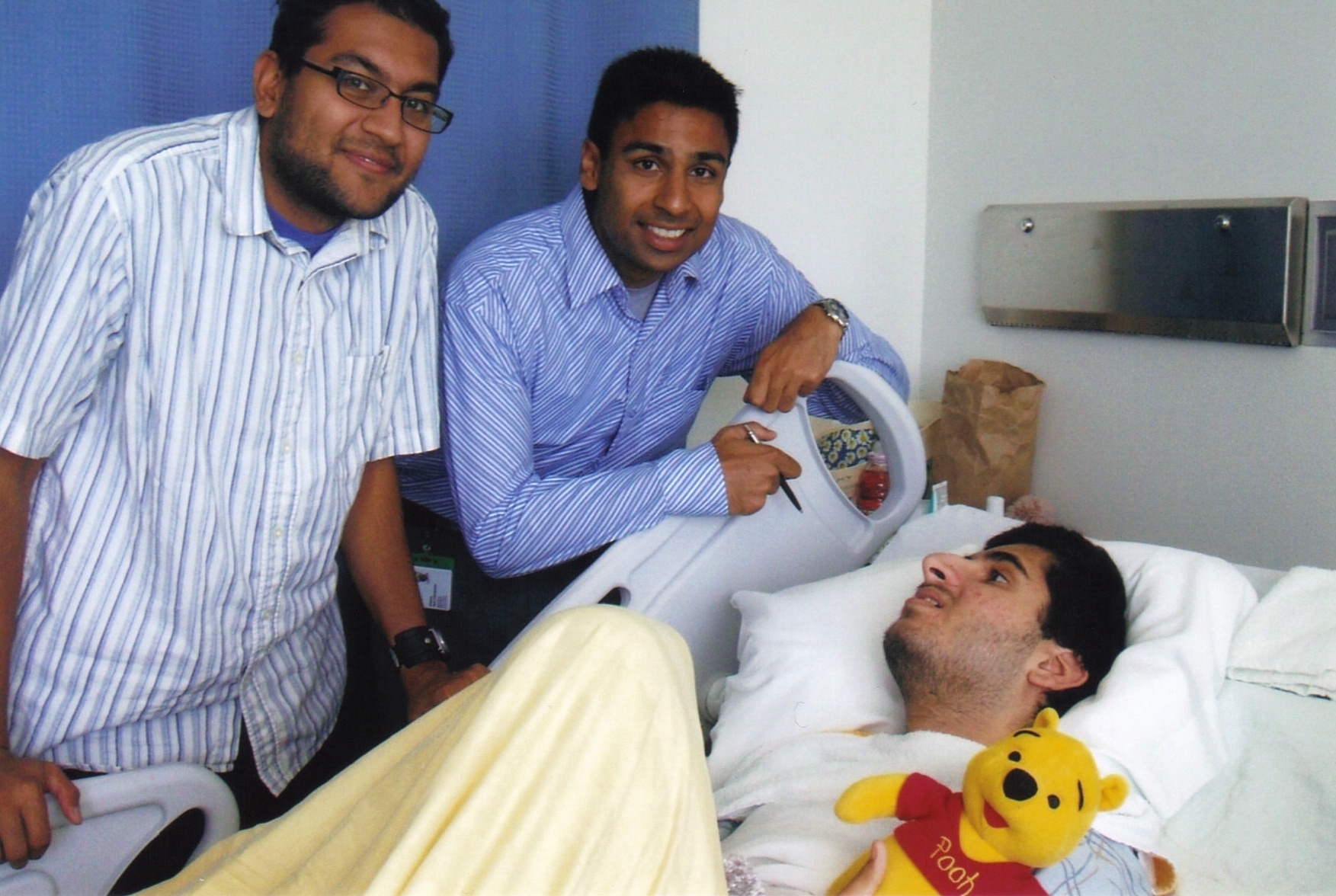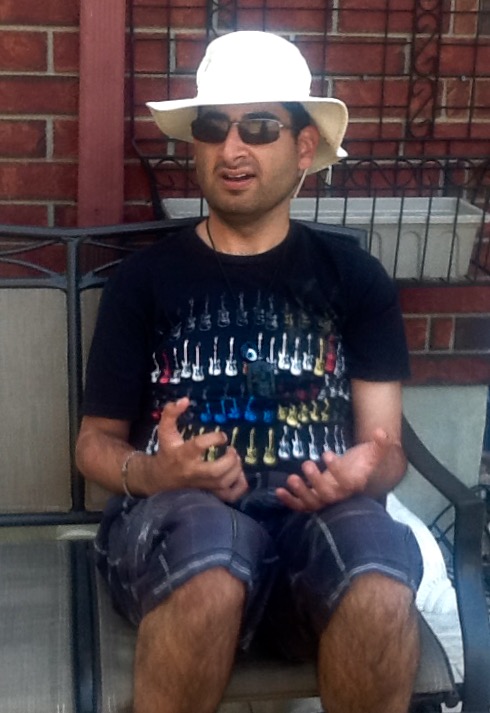Tommy Jaworski
Everyday, 30-year-old Tommy Jaworski sits in his rocking chair and flips through his growing collection of postcards.
“I think it lets him explore the world from his point of view,” said his mother, Zeno.
Tommy has always been fascinated with geography. Growing up, he had an eight-by-six-foot map of the world on the wall of his room and, just for fun, he’d find the places his postcards had been mailed from.
Tommy suffers from a genetic illness called the “opposite of William syndrome,” a brain condition he has lived with since birth. It has left him with severe developmental delays and the inability to communicate verbally.
While Tommy was never specifically diagnosed with mental illness in his early years, Zeno said he exhibited many kinds of obsessive-compulsive behaviours that she simply brushed off and considered part of his neurological impairment.
“He’d play and if you’d move something by an eighth of an inch, he’d know it. Whether it was his train tracks or books or movies on the shelves, he was obsessed with having everything just so,” said Zeno.
By the time Tommy was 14 years old, he had had multiple brain surgeries and was in and out of the hospital routinely. Zeno suspected Tommy suffered from depression during these periods because his everyday routine had been taken away from him.
“That’s the only mental illness I could actually say for sure that he suffered from,” she said.
Despite Tommy’s challenges, Zeno made sure her son lived as normal a life as possible. Although he never actually completed the curriculum, Tommy attended all 12 grades of school and was able to complete his secondary education by the age of 21 with the help of an educational assistant. He enjoyed reading, playing the keyboard and was a very talented painter. While some aspects of his life were a struggle, Tommy generally had a very happy upbringing.
But that rapidly changed over the course of a single week in 2006.
Shortly after Tommy completed high school that year, he became rigid, scared and lethargic. The situation quickly escalated when Tommy stopped eating and drinking and going to the bathroom, Zeno said. He lost 14 pounds in just 10 days.
After weeks of shuffling back and forth between the neurology and psychiatry departments at The Ottawa Hospital, Tommy was eventually diagnosed with catatonia, a mental disorder characterized by a state of apparent unresponsiveness.
Voice of Zeno Jaworski, Tommy's mother (Video © Hayley Chazan)
Once Tommy was admitted to the hospital, his doctors tried everything they could to get his catatonia to break. They first turned to medication, but ran into difficulty finding the right cocktail that wouldn’t cause his breathing to slow down. After weeks of struggling to achieve the right balance of drugs, Tommy’s psychiatrists suggested Electroconvulsive Therapy.
During his catatonic episodes, Tommy feels like ants are crawling in his head. This is a common symptom of his illness. (Videos courtesy of Zeno Jaworski)
At that time, Zeno knew very little about ECT other than the horrible scenes she had seen in old movies. Before she consented to the treatment, she was given a video to watch, which explained how the procedure worked and helped shed light on the differences between the stereotypes and actual, modern-era ECT.
The choice Zeno faced at that time symbolized ECT’s divided reputation. The archaic, barbaric procedure perpetuated by pop culture versus a modern day, effective treatment, capable of helping even the most hopeless and vulnerable patients.
The fact that patients and their families have to watch a movie in the first place just to understand how ECT actually works, even to this day, is demonstrative of how much of a negative impact films like “One Flew Over the Cuckoos Nest” had on shaping the perception of the general public.
“I was told at the time that ECT was really our last hope of saving his life, so it wasn’t really an option anymore,” she said.
The doctors told Zeno that to pull Tommy out of his catatonic episode, he would need four ECT treatments, one every second day. But Tommy’s catatonia was so severe that it took 12 treatments to be able to see even the slightest improvement, and he ended up having to spend five months in the hospital.


Tommy spent five months in the hospital in 2006 during his first catatonic episode (Photos courtesy of Zeno Jaworski)
Since being released from the hospital nearly 10 years ago, Tommy has been receiving regular ECT treatments on an outpatient basis every two weeks as a preventative measure in conjunction with medication.
“That keeps him going,” said Zeno. “But after day nine, we see the slide. And sometimes we see the slide the whole two weeks. Not every ECT is as effective as the last one and there’s no rhyme or reason for that.”
Zeno did say, however, that if either the drugs or the ECT were stopped, Tommy would end up back in the hospital. She was warned that if Tommy ever got into such a deep catatonic state again, the doctors might never be able to get him out of it and he could potentially die within twelve weeks. That’s why, Zeno said, it is so imperative that Tommy never miss a week of treatment or a dose of his daily drugs.
Although Tommy’s ECT schedule can be burdensome at times, Zeno said the first-class care Tommy consistently receives from his team of healthcare professionals at The Ottawa Hospital has made the process a lot easier.
From day one, Zeno said, Tommy’s psychiatrist, Dr. Kiran Rabheru, has allowed her to be part of the treatment.
“I’ve always had the choice of actually staying in the room with Tommy for the entire treatment or just up to the prep time until he’s anesthetized,” said Zeno. “I’ve always opted for the latter.”
To limit Tommy’s anxiety, Zeno said that Dr. Rabheru and his team always make sure he is the first person in for treatment on a given day. Dr. Rahberu has also allowed Zeno to bring music and an iPad into the procedure room to make Tommy more comfortable.
While ECT appears to have quite literally saved Tommy’s life, it has unfortunately come at a cost. When Tommy was younger, he used to be a talented piano and keyboard player. Zeno said he used to jam with one of his neighbours throughout high school and played in school concerts and at church. Tommy loved music more than anything, but shortly after his treatments began, he lost his ability to play.
Zeno said that in order to try to restore Tommy’s musical abilities, Dr. Rabheru altered his treatment, switching from bilateral ECT to unilateral ECT. Bilateral ECT involves placing the electrodes on both temples. This type of ECT is the most effective for severe mental illnesses like catatonia. On the other hand, unilateral ECT consists of one electrode placed on the crown of the head and the other on the right temple. While this type of placement is generally less effective, it is associated with fewer negative side effects.
Dr. Rabheru thought that the unilateral electrode placement might limit the impact on the part of Tommy’s brain that he needed to play music. But unfortunately, the unilateral placement wasn’t effective enough to get Tommy out of his episodes and the doctors were forced to revert back to their original course of treatment.
“It’s really sad, because Tommy’s played music since he was two,” said Zeno.
Zeno says she’s hopeful that a more effective method of ECT will come along sometime in the future that will allow Tommy to regain his musical abilities.
A small group of psychiatrists in Canada are hopeful that impending guidelines to standardize how ECT is delivered will eventually help to minimize cognitive side effects in patients like Tommy.
The Canadian ECT standards document, which will be released in the next few months, will help centres across the country deliver ECT at the highest possible level, consistent with the latest research and developments in the field. The document, which is ten years in the making, is the result of a national survey of ECT in Canada that was carried out between 2006 and 2007. The survey revealed that there are large variations in how ECT is delivered across the country.
The group believes that a higher quality ECT treatment, performed consistently across Canada, will make it easier for psychiatrists to track outcomes and determine what works and what doesn’t. This will eventually lead to further research and new discoveries. The standards document is in no way final, and the plan is to publish many versions over the years in order to reflect ongoing improvements in the field.
While Tommy has lost his ability to play the keyboard, he still loves to sing, in his own way, Zeno said. He’ll sometimes burst into song at a moment’s notice.
Tommy singing O'Canada
Despite the negative side effects, Zeno said that with ECT, Tommy can at least have a quality of life that he can enjoy. It might not be perfect every day, she said, and some days may be spent curled up on the couch, but he certainly does get to live his life.

